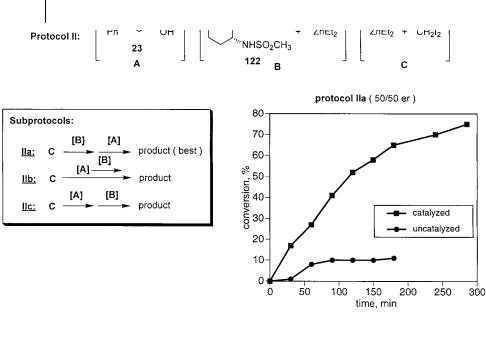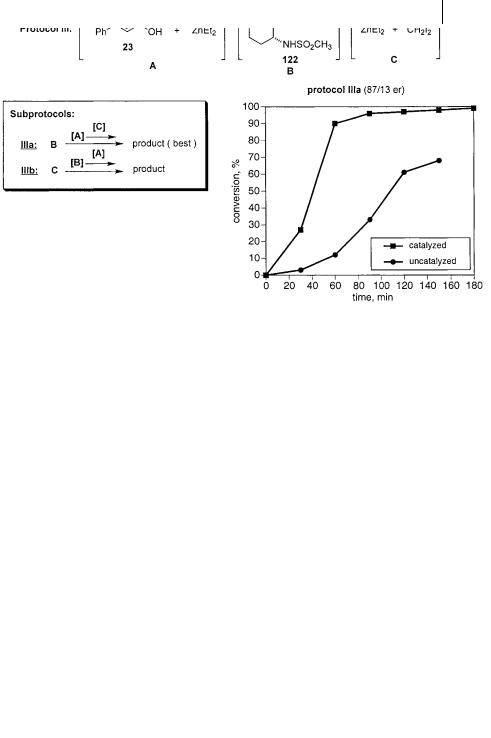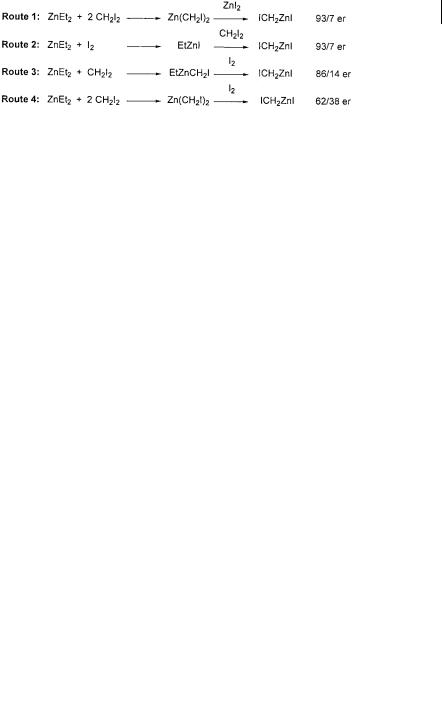
Cycloaddition Reactions in Organic Synthesis
.pdf
128 3 Enantioselective [2+1] Cycloaddition: Cyclopropanation with Zinc Carbenoids
non-coordinating solvents are employed, either dichloromethane or 1,2-dichloro- ethane. Because the background reaction is competitive, these reactions are run at –23 C to suppress the uncatalyzed process. The test substrate is cinnamyl alcohol (23) and, in all cases, the Furukawa reagent (Zn(CH2I)2) is used as the methylene transfer agent. Several pieces of information regarding the cyclopropanation protocol are presented in figures below (Figs. 3.12–3.15 and 3.18). Each figure depicts one of the general protocols examined during the course of the study. The line of reagents in brackets at the top of the figure represents how the reagents are combined and how many flasks are employed. Each set of brackets represents one flask. The equations below this to the left then signify the order in which the reagents are combined or, more often, the order in which the pre-formed reagents are transferred from one flask to the next. Lastly, the graph on the lower right is representative of the rate profile for the best sub-protocol in each set. These graphs show that most protocols are conducted both with and without promoter. This measure of the rate enhancement or “split” between the catalyzed and uncatalyzed processes is useful in judging the overall efficacy of the catalyst system in question.
In Kobayashi’s original procedure, the sulfonamide catalyst and the alcohol are combined in a single flask before addition of the diethylzinc and the diiodomethane (Fig. 3.12) [72 a]. Sub-protocols Ia and Ib show two of the variations of this original procedure. In both cases, a solution containing the promoter is added to a flask charged with the allylic alcohol. In sub-protocol Ia the diethylzinc is added to the alcohol/promoter solution before the diiodomethane. This addition order is found to be superior to the reversed order of sub-protocol Ib. Upon examination of the rate profile for sub-protocol Ia, the promoter clearly provides a good rate enhancement. The catalyzed process can provide high enantioselectivity (87 : 13 er), although irreproducibility plagues this particular protocol. The beneficial effect of adding the diethylzinc before diiodomethane suggests that deprotonation of the promoter and/or alcohol must precede formation of the zinc carbenoid. It is interesting to note that both the catalyzed and uncatalyzed processes exhibit a long induction period (ca. 60 min). This phenomenon is common to most of the early reaction protocols and will be an important clue to a deeper understanding of the reaction mechanism.
Whereas this study focused on reaction protocol, the effect of the methylene source on selectivity was another important factor which demanded attention. Earlier studies have demonstrated that substitution of chloroiodomethane for diiodomethane leads to an increased reaction rate (Scheme 3.10) [22]. It is, thus, surprising that the use of chloroiodomethane in sub-protocol Ia leads a slower, less selective reaction. In contrast to the use of diiodomethane ( 100% conversion at 300 min), the reaction of chloroiodomethane only reaches 58% conversion after 300 min. Selectivity is severely reduced, dropping to 75 : 25 er. The failure of this reagent in the chiral process may be attributed to the obvious differences between the highly polarizable iodine and the more electronegative chlorine atom, although an exact analysis of the difference is not clear.
Having confirmed the importance of independent formation of the zinc carbenoid, other factors could be examined (Fig. 3.13). Protocol II was developed to test

3.4 Stereoselective Simmons-Smith Cyclopropanations 129
Fig. 3.12 Protocol I
for the importance of pre-forming the zinc alkoxide. In these three flask protocols, each reagent could be prepared separately allowing for testing the affect of specific reagent preparations. In all sub-protocols, the alcohol and promoter solutions (A and B, respectively) are transferred to flask C, containing the preformed zinc carbenoid. Flask B contains the deprotonated sulfonamide while flask A simply contains a solution of the allylic alcohol. In sub-protocol IIa, the deprotonated sulfonamide is added to the carbenoid reagent prior to addition of the alcohol. In sub-protocol IIb, the sulfonamide solution is mixed with the alcohol prior to addition of this mixture to the flask containing the carbenoid. Sub-protocol IIc simply reverses the addition order of IIa by adding the alcohol to the carbenoid solution prior to addition of the zinc-sulfonamide. Although each protocol provides a rate enhancement over the uncatalyzed process, none of them is able to provide a rapid and selective reaction. Examination of the rate profile of sub-protocol IIa, the best protocol in this sub-set, shows a sluggish reaction which stalls after approximately 3 h. It is surprising that this protocol yields racemic product. The failure of this sub-protocol to yield an enantioselective reaction indicates that the zinc alkoxide is essential for the asymmetric, catalytic reaction. Protonolysis of either the zinc sulfonamide or the zinc carbenoid by this reagent is clearly detrimental.
Having observed that: (i) the zinc carbenoid must be formed prior to addition of the alcohol or sulfonamide; and (ii) that the zinc alkoxide should be preformed in order to obtain high selectivity, the importance of the zinc sulfonamide could be assessed (Fig. 3.14). In this sub-set, flask A contains the preformed zinc alkoxide, flask B contains the promoter solution and flask C contains the preformed zinc carbenoid. In sub-protocol IIIa, flasks A and C are combined prior to addi-

130 3 Enantioselective [2+1] Cycloaddition: Cyclopropanation with Zinc Carbenoids
Fig. 3.13 Protocol II
tion to flask B. Sub-protocol IIIb requires a slightly different addition order, the combine contents of flasks A and B being transferred to the solution of the zinc carbenoid. Sub-protocol IIIa is found to be superior and examination of its rate profile shows an acceptable enhancement over the uncatalyzed process. Again, the unexplained induction period is observed as in the case of sub-protocol Ia. Still, the observed 87 : 13 er is comparable with Kobayashi’s original procedure. This result suggests that deprotonation of the sulfonamide is not a contributor to the selectivity observed in original protocol. Since the sulfonamide is only present in a catalytic amount (10 mol%), its deprotonation by either the zinc alkoxide or the zinc carbenoid may not perturb the system enough to disrupt the selective pathway. However, this result is somewhat misleading.
Although the previous protocol suggests it is not necessary to deprotonate the sulfonamide prior to exposure to the zinc carbenoid, a experimentally simpler procedure can be envisioned wherein the alcohol and promoter are deprotonated in a single flask (Fig. 3.15). In protocol IV, the alcohol and promoter are combined in flask A and are treated with diethylzinc, thus forming the zinc alkoxide and zinc sulfonamide. In sub-protocol IVa, this solution is transferred to flask C which contains the zinc carbenoid. Sub-protocol IVb represents the reversed addition order. Sub-protocol IVa is not only found to be the superior protocol in this sub-set, it is found to out-perform all of the previous protocols! Despite the persistence of the induction period, a large rate enhancement over the uncatalyzed process is observed. This considerable rate enhancement also translates to a reduction in the overall reaction time when compared to sub-protocols Ia and IIIa. Selectivity rises

3.4 Stereoselective Simmons-Smith Cyclopropanations 131
Fig. 3.14 Protocol III
Fig. 3.15 Protocol IV

132 3 Enantioselective [2+1] Cycloaddition: Cyclopropanation with Zinc Carbenoids
to 90 : 10 er using sub-protocol IVa. This experiment asserts the importance of preformation of both the zinc carbenoid and the zinc alkoxide. Despite the results of sub-protocol IIIa, these experiments have shown that preformation of the zinc sulfonamide complex is key to both the reproducibility of the reaction and to higher selectivities.
Even though these studies provided new insights into the cyclopropanation process, only minor gains in selectivity could be achieved. The question of the induction period still remained [77]. The sigmoidal rate profile is suggestive of an autocatalytic process, i.e., the concentration of the active catalyst increases as the reaction proceeds. This could arise if a by-product of the reaction is necessary for formation of the catalytically active species. Another consequence of such a process would be a difference in enantioselectivity between the early and late stages of the reaction. Fig. 3.16a simultaneously depicts conversion and enantiomeric composition at each time point. Clearly, a strong conversion dependence on the enantioselectivity of the reaction is observed. During the induction period, selectivity is clearly lower, but changes dramatically as the amount of product increases. This indicates that some change in the nature of catalytic species is occurring over the course of the reaction.
Understanding the mechanistic significance of this induction period is aided by contemporary knowledge of the dynamic behavior of zinc carbenoids. The sole byproduct of this reaction is ZnI2. Because zinc carbenoids are subject to the Schlenk equilibrium, one can imagine that the accumulation of ZnI2 changes the predominant carbenoid species in solution. In the preceding optimization studies, the Furukawa procedure is employed (2 : 1 CH2I2–ZnEt2). On the basis of stoichiometry and previous NMR studies, Zn(CH2I)2 is the initially formed carbenoid reagent [32, 33], but in accordance with later NMR studies, ICH2ZnI should form in the presence of ZnI2 [35]. These studies suggest that iodomethylzinc iodide can become the predominant species, even if Zn(CH2I)2 is the initially prepared reagent. Hence, the selectivity of the catalyzed process with Zn(CH2I)2 may differ from that observed with ICH2ZnI. If the conversion dependence of the enantio-
(a) |
(b) |
Fig. 3.16 The effect of ZnI2 on the enantioselectivity of the cyclopropanation

3.4 Stereoselective Simmons-Smith Cyclopropanations 133
selectivity is recorded for a reaction preformed in the presence of 1 equivalent of ZnI2, the induction period vanishes and enantioselectivity remains fairly constant (Fig. 3.16b). Presumably, the presence of ZnI2 at the outset of the reaction rapidly transforms the active zinc carbenoid from Zn(CH2I)2 to ICH2ZnI. While the Zn(CH2I)2 reacts through an unselective pathway, ICH2ZnI is capable of a competitive reaction through a more selective route.
Proof for the pivotal role of ICH2ZnI was provided by a combination of product analysis and NMR spectroscopy. Charette had shown that, once formed, ICH2ZnI does not disproportionate to ZnI2 and Zn(CH2I)2 when complexed [35]. This demonstrates that the equilibrium lies to the side of ICH2ZnI. Thus, as the reaction proceeds and the concentration of zinc iodide increases, the preformed Zn(CH2I)2 rapidly disproportionates into ICH2ZnI. Thus, if ICH2ZnI is preformed and used in the reaction, the induction period should be eliminated. In this study, Denmark devised four routes to produce iodomethylzinc iodide (Fig. 3.17) [77]. The identity of the resulting carbenoid is assessed by formation of the complex with 27 and its analysis by 13C NMR spectroscopy. The four routes are shown below. Although all routes yield a new species which could be assigned as the complex 27-iodomethylzinc iodide, not all methods gave this material exclusively. Routes 1 and 2 were the cleanest and accordingly also afforded the cyclopropanation product in a good yield and with high enantioselectivities (93 : 7 er). Routes 3 and 4 produced slower, less selective reactions. The ability to independently generate ICH2ZnI from a number of routes, confirm its formation by spectroscopy and demonstrate the ability of that species to function under the influence of the catalyst provides compelling support for the intermediacy of iodomethylzinc iodide in the asymmetric process and highlights the importance of the Schlenk equilibrium for creating this species from the initial reagents.
Having established the importance of ZnI2 in the formation of a protocol which incorporates this pivotal factor was developed (Fig. 3.18) [77]. Flask A contains the fully deprotonated alcohol and sulfonamide. Flask B contains a solution of ZnI2 which is generated from the combination of diethylzinc and elemental iodine. This procedure was adopted due to the hygroscopic nature of ZnI2. By forming the salt in situ under anhydrous conditions, water can be rigorously excluded. Finally, flask C contains the preformed Furukawa reagent, Zn(CH2I)2. The fully deprotonated alcohol and zinc sulfonamide (A) are added to a solution of in situ generated ZnI2 (B) prior to transfer of this combine mixture to the zinc carbenoid (C). This protocol
Fig. 3.17 Cyclopropanation under protocol V using different zinc carbenoids

134 3 Enantioselective [2+1] Cycloaddition: Cyclopropanation with Zinc Carbenoids
Fig. 3.18 Protocol V
consistently gives a 93 : 7 er in the cyclopropanation of cinnamyl alcohol; it takes into account all the conclusions of earlier protocol development and clearly benefits from them.
Although this procedure is able to provide the highest selectivities yet observed, a major concern remained the heterogeneous nature of the reaction. Once formed, zinc sulfonamides are only sparingly soluble in dichloromethane [77]. Even dilute solutions of zinc sulfonamides form a gel-like substance which can only be dissolved upon addition of 2,2 -bipyridyl. If the catalytic species is only sparingly soluble in the reaction medium, low catalyst concentrations can contribute to lowered enantioselectivity. This interesting behavior is explained through the proposed formation of a network 76 (Fig. 3.19). Interaction between the Lewis acidic zinc atom of the sulfonamide and the Lewis basic sulfonyl oxygens of neighboring complexes will readily yield a dimer. Further aggregation quickly leads to the formation of the polymer which does not act as a catalyst for the reaction. Hence its formation can be viewed as detrimental to the overall process.
The impact of catalyst polymerization can be seen in the unusual loading dependence of the enantioselectivity (Fig. 3.20 a). At low catalyst loadings (< 10 mol%), low selectivity can be attributed to competition from the unselective, uncatalyzed pathway. At high catalyst loadings (> 20 mol%), selectivity is also dramatically reduced. Higher catalyst concentrations may lead to a greater degree of aggregation. A decrease in the ratio of monomeric to aggregated catalyst would again correspond to increased competition from the unselective, uncatalyzed pathway.

3.4 Stereoselective Simmons-Smith Cyclopropanations 135
Fig. 3.19 Proposed zinc-sulfonamide network
Although reaction is proposed to occur through a monomeric catalyst, the polymeric aggregate 123 may influence the enantioselectivity of the cyclopropanation process. Support for this is derived from the observation of a small, but clearly negative, non-linear effect on product enantioselectivity as the enantiopurity of the catalyst is varied (Fig. 3.20 b) [78]. This phenomenon again suggests that there are aggregation processes occurring for the catalyst molecules. Since some non-linear effects are explained in terms of an inactive aggregate, it is attractive to analyze this behavior in terms of the well established “reservoir effect” [79]. In the reservoir effect, an equilibrium between a reactive monomer and an unreactive aggregate is assumed. The stability of the aggregate is affected by how well the molecules interact with themselves (homochiral) or their enantiomers (heterochiral). A negative non-linear effect can be interpreted as a formation of a more stable, homochiral aggregate. Although the current data does not provide for an interpretation of this phenomenon, its existence is clear. The observation of a non-linear effect does agree with the formation of an unreactive catalyst aggregate.
To optimize selectivity, a wide array of diamine backbones were surveyed (Fig. 3.21). However, it appears that 1,2-cyclohexanediamine is unique in its catalytic properties. Only the closely related dihydrophenanthrene ligand 124 could
Fig. 3.20 (a) Dependence of enantioselectivity on loading. (b) Non-linear effect on enantioselectivity

136 3 Enantioselective [2+1] Cycloaddition: Cyclopropanation with Zinc Carbenoids
match the selectivity observed with the simpler ligand 122. Upon examination of the other, distinct ligand structures, a number of trends are apparent. First, the dihedral angle is important to catalyst activity and selectivity. Both the 1,2-cyclohexa- nediamineand dihydrophenanthrene-derived sulfonamides with angles near 60 , give high selectivities. However, increasing the dihedral angle, as in the 9,10-dihy- dro-9,10-ethanoanthracene 125 ( 120 ) or the 1,1 -binaphthyl-2,2 -diamine 126 ( 90 ), lowers both reactivity and selectivity. Increasing the flexibility of the diamine backbone by use a substituted 1,3-diaminopropane tether as in 128 is a poor choice. Other structural variations, such as use of a sulfonamido ether 129 or a monodentate sulfonamide 130, also prove unsuccessful.
Another point for structural diversification is the sulfonamide group. Imai had already shown that a wide variety of groups could be introduced at this position to optimize the reaction. Since a wide variety of sulfonyl chlorides are commercially available, a number of different types of groups could be examined (Scheme 3.34). Testing of a variety of aryl and alkyl groups on the 1,2-cyclohexanediamine backbone demonstrates that the simple methanesulfonamide 122 is clearly superior or equal to many other analogs in the cyclopropanation of cinnamyl alcohol (Table 3.11). Another concern which was directly addressed by this survey was the question of catalyst solubility.
The steric bulk of the sulfonamide group has a strong influence over the enantioselectivity of the process. Examination of the Table 3.11 shows that smaller, compact groups allow for higher selectivity. The most selective catalysts contain straight chain alkyl groups such as in 122 and 131a–c. Branching in the pendant alkyl group as shown in 131d–e leads to a considerable decrease in selectivity. Aryl groups were able to give high selectivities, as in the case of catalysts 114d
Fig. 3.21 Studies on the diamine backbone

3.4 Stereoselective Simmons-Smith Cyclopropanations 137
Tab. 3.11 |
Cyclohexane-1,2-bissulfonamides |
|
|
|
|
|
|
|
|
Entry |
Catalyst |
R |
er (24) |
|
|
|
|
|
|
1 |
122 |
Me |
93 |
: 7 |
2 |
131a |
Et |
90 |
: 10 |
3 |
131b |
n-Bu |
92 |
: 8 |
4 |
131c |
n-Oct |
93 |
: 7 |
5 |
131d |
i-Pr |
86 |
: 14 |
6 |
131e |
t-Bu |
76 |
: 24 |
7 |
114d |
4-NO2C6H4 |
89 |
: 11 |
8 |
131f |
1-Naphthyl |
85 |
: 15 |
9 |
131g |
Mesityl |
62 |
: 38 |
10 |
131h |
CF3 |
53 |
: 47 |
11 |
131i |
Me/i-Pr |
92 |
: 8 |
12 |
131j |
Me/1-naphthyl |
93 |
: 7 |
13 |
131k |
CH3/CF3 |
59 |
: 41 |
|
|
|
|
|
and 131 f. However, the sterically bulky mesityl group (131g) again compromises the selectivity of the reaction.
Because sulfonamides are known to aggregate in solution, it was originally thought that larger, more solubilizing groups could disrupt aggregation and lead to higher enantioselectivities. Many of the catalysts in Table 3.11 show increased solubility relative to the methanesulfonamide 122. Both the n-butyl (131b) and n-octyl (131c) sulfonamides are highly soluble, yet their use does not lead to increased selectivity relative to the methane sulfonamide 122. The use of bulky alkyl groups such as t-butyl 131e also render the complex highly soluble, but the increased steric bulk around the central zinc atom also compromises selectivity. In the case of these highly solubilizing sulfonamides, it is interesting to note that the final reaction mixture becomes heterogeneous despite the initial solubility of the zinc-sulfonamide complex.
The fluorinated sulfonamide 131h (entry 10) behaves in a very different manner from the methanesulfonamide 122. Just as Kobayashi observed, perfluorinated sulfonamides have little in common with their hydrogen-containing analogs. Although CF3 sterically resemblesan i-Pr group, ligand 131h clearly differs from 131d, suggesting something beside a steric interaction [80a]. The possibility of zinc-fluorine interactions has been suggested in the literature [80b]. The effect of metal-fluorine interactions has been proposed as an explanation for the unpredictable nature of many fluorinated catalysts [81].
Examination of the results of the unsymmetrical sulfonamides 131i–k (entries 11–13) reveals an interesting trend. The methyl/i-propyl sulfonamide 131i repre-
